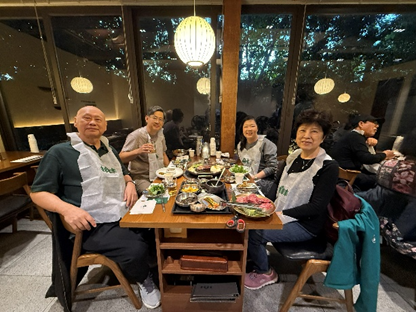My son Shen-Yang
and his partner Ai Huey had been invited to speak at a medical conference in
Jeju, and he asked if we would like to join them to tour the island.
We flew in on 31 October.
For the first two days, they were completely tied up with their conference commitments. We set aside the following three days to explore Jeju together.
I had rented a
car to drive around the island. I was pleasantly surprised that they were
willing to let a 76-year-old man take the wheel — provided I had an
international driving licence. (Shen-Yang was too busy to apply for one.)
Getting it from the Road Transport Department at its Petaling Jaya office was
as easy as a walk in the park.
Koreans drive on the right side of the road, and I had never handled a left-hand-drive car in my life. So, I was a little apprehensive at first. The airport sits on the northern coast, while our hotel — Lotte Hotel Jeju — is on the opposite side of the island. The drive took about an hour. It turned out to be not difficult at all. Saw Hwa was an excellent navigator.
During the first
two days, we drove aimlessly along the western coast — knowing full well that
once Ai Huey was free, she would have all the proper sightseeing spots lined
up. Still, we did manage to visit a Buddhist temple which, like most in Korea,
exuded a quiet spiritual gravitas.
We also went to the city’s wet market and enjoyed the finger food there.
I am not good at remembering places, but I believe we covered much of the island in the last three days when all four of us travelled together. However, I simply could not recall the places we had visited on our previous trip — taken perhaps 20 years ago. I remember a spot where the tour guide demonstrated a David Copperfield–like illusion: our coach appeared to be going downhill when it was actually climbing uphill. I also recall visiting a well-known drama prop-village, whose owner proudly told us she had acted in the show.
Jeju is an island born of volcanic eruptions, and many of its attractions revolve around this geological heritage. We also took a ferry to visit Go Island. “Go” means “cattle” (牛, Niú — if you speak Minnan, you’ll notice how close many Korean words can sound to Minnan). But we didn’t see any cattle there; we saw only a few horses. There wasn’t much to see on the island. The buggy we hired to circle the place was a rip-off — though we rented it with eyes wide open.
(I have always felt that, out of a sense of national pride, both Korea and Vietnam have largely abandoned the use of Chinese characters in their writing systems. A purely phonetic script certainly has its merits, but in these two cases it also means losing the original meaning and deeper roots of many words. As a result, many Koreans and Vietnamese today may not fully understand the foundations or meanings of their own names—names that their parents had often chosen with great care—unless they also know some Chinese.
To me, this kind of nationalism feels somewhat misplaced. At the same time, we Chinese must also recognise that many of our neighbours view us with a degree of discomfort, if not hostility. That sentiment, too, is part of the reality we have to acknowledge.)
Jeju is about 2½ times the size of Singapore, but it has no MRT. The roads are good but not particularly enjoyable to drive on. The top speed is 80 km/h, and many stretches are capped at 50. There are numerous child-protection zones with a strict 30 km/h limit. Cameras are everywhere. As much as I tried to comply, I suspect I may have exceeded the limit a few times.
We also sampled some of Jeju’s signature restaurants. The food was generally good — though not particularly great.

My son remarked
that my driving was solid! Not bad for a 76-year-old!
That is enough of Jeju for now.
End

From the little I know about Jeju Island, it's known for its women free divers who scour the sea bed for pearls and seafood without the use of breathing apparatus. I don't know if this is still practiced in modern Korea. Can't say if the delicious seafood you savoured in Jeju Island was hand -harvested by these remarkable women.
ReplyDeleteThanks for pointing out, Dato' Yeang. Indeed, no account of Jeju can be complete without a mention of the haenyeo - the island's famed women divers. Unfortunately, I understand only a dwindling handful still practise the tradition, and most now perform primarily for tourists.
Delete